|
|

|
|
|
|
Horseback riding vacations in
Spain
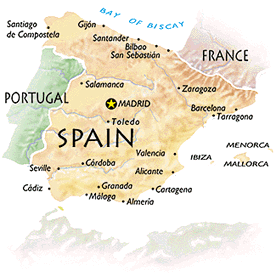
Join Hidden Trails on some of the best horse riding vacations in Spain. Spanish horse riding holidays have a lot to offer and are as diverse as dressage clinics, trail rides, and gourmet food vacations. Hidden Trails offer equestrian tours in some of Spain’s most stunning locations – from Catalonia to Central Spain and Mallorca to Southern Spain. On a horseback riding holiday in Spain you will uncover hidden valleys, bask in the Mediterranean sunlight and dine of the finest wine and food.
Horse Riding in Spain
There is more to Spain than just bullfights and flamenco dancers. This vast country in the Mediterranean is home to mountains, hills, valleys, never ending beaches, islands and amazing wine regions.
In Catalonia, our horse rides meander through volcanic landscapes, beautiful beaches and traverse the mighty Pyrenees mountain range.
Central Spain is a gourmet extravaganza – our “Vineyard Trail” ride is in an area boasting over 8000 wine makers! Here, you will also encounter the wonders of Madrid, and many small medieval villages in the Gredos Mountains and Extremadura Valley.
In Galicia, you can ride on several routes leading to Santiago de Compostela. The French Route is the most popular, but you can also opt for more quiet Northern Route or go beyond Santiago to Fisterra.
The Balearic island of Mallorca and Menorca are other excellent horse riding locations.
Finally, Andalucia in Southern Spain, is also a popular horse riding region with diverse landscapes. The Sierra Nevada Ride will take you across the surprising Tabernas desert, while our Romantic Road to Ronda lets you explore charming villages. We also offer a splendid ride to Donana National Park.
Check out our dressage clinics under the instruction of former Olympian medalist Rafael Soto.
The Andalusian (Spanish Horse)
Spain is famous for its Spanish Horse (Andalusian). The Andalusian is believed to be the most ancient riding horse in the world. Although the origins of the breed are not clear, Spanish experts adamantly maintain that it is in fact a native of Spain and does not owe one single feature of its makeup to any other breed. In the 15th Century the Carthusian Monks founded the most famous lines of the Spanish horse on the Fuente del Suero estate Jerez. The Stud was called "Hierro del Bocado" and was situated in the beautiful grounds of the Guadalete's valley next to the Carthusian Monastery. The Carthusian Monks developed a herd that became one of the most appreciated in the world. The Spanish horse has certainly made a lasting impact on many of the worlds breeds, including the Mustang, Quarter Horse Appaloosa, Peruvian Paso, and Paso Fino.
Spanish History and Culture
Spain has a tremendous history – reflected in prehistoric cave paintings, Moorish palaces, crumbling castles, Roman ruins, Gothic and Renaissance cathedrals as well as some very distinctive modern architecture. The uniqueness of Spain lies in the separate kingdoms which made up the original Spanish nation. These regions remain diverse in their language, culture, cuisine and art. They include: Andalucía, Aragon, Asturias, Basque Country, the Balearic Islands, the Canary Islands, Cantabria, Castilla La Mancha, Castilla León, Catalonia, Extremadura, Galicia, La Rioja, Madrid, Murcia, Navarra and Valencia.
Spanish Weather and Climate
Summers in Spain generally experience highs of around 28 °C in the height of summer. Winters are mild, with lows around 10 - 13 °C.
Explore more European Horse Riding Vacations
|
|
Holidays on horseback in Spain
See Mini Country Guide
|

|
|
Pryor Mountains Horse Drive
(HDMT01)
Wyoming, USA
7 days / 6 nights, rate from
$2,500
The Pryor Mountains Ranch is an authentic working cattle and quarter horse ranch located in the Dryhead Canyon on the east slopes of the Pryor Mountains. We invite you to join us and experience a lifestyle you’ve only seen in the movies - here you can experience first hand a real horse drive or round up, cattle drive or branding of your own calf and riding an agile and well trained cow horse. Horse drives and round ups in the United States are becoming a rare experience. Working with horses is a wonderful thrill and we want to share this unique love with all of our guests that come to Wyoming to visit the ranch. All of us and all our guests share the common bond of loving horses. The Pryor Mountains Ranch offers a great opportunity to see horses in their natural environ...
Minimum riding level: Intermediate

|
|
Below is a list of our trips in this area with video clips.
 Click on the 'watch video' icon

to view a video clip,
Train and Trail in Spain

|
A riding holiday that was designed for those who share our passion for horses. The combination of "trail and training" is ideal for riders who believe that trail riding is one of the best ways to have fun, make new friends, relax from the stress of modern-day lifestyles and see Spain from another angle, while devoting some time to improving your horse riding skills so that your confidence in, and enjoyment of horses, will increase greatly over the week.
|
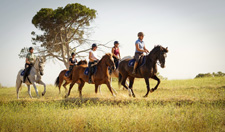
Trip Details
|
|
Train in Southern Spain

|
A riding holiday that was designed for those who share our passion for horses. The combination of "trail and training" is ideal for riders who believe that trail riding is one of the best ways to have fun, make new friends, relax from the stress of modern-day lifestyles and see Spain from another angle, while devoting some time to improving your horse riding skills so that your confidence in, and enjoyment of horses, will increase greatly over the week.
|

Trip Details
|
|
Spain
Travel restrictions
From October 21st 2022, all COVID-19 travel restrictions for travelers to Spain have been lifted.
From January 3rd 2023, Spain has reinstated mandatory COVID-19 vaccination and testing requirements for all passengers arriving from China. Travelers from China will be required to undergo visual and temperature checks on arrival and may be subjected to a diagnostic test for active infection at the point of entry. Children under the age of twelve are exempt from this requirement.
For all other passengers, Spain does not require any proof of vaccination, a negative test result, or a COVID-19 recovery certificate to enter the country, regardless of your vaccination status.
Measures taken by the government
A mask covering your mouth and nose is mandatory in a pharmacy, or in a medical facility.
Testing
Travelers can obtain a COVID-19 test in Spain by paying an average of €30 for an antigen test, or €120 for a PCR test from a private medical facility, such as those on the Covid Testing Locations list: https://es.usembassy.gov/wp-content/uploads/sites/260/COVID19_Testing_Labs_Spain_January_2021.pdf
Results are typically provided by email, but an original signed results record will be provided upon request.
Emergency number (related to COVID-19) while visiting the country
There are reports that emergency medical services (telephone numbers 112 and 061 from within Spain) are stressed and that responses are delayed.
Source:
US Embassy in Spain https://es.usembassy.gov/covid-19-information/
Published on February 14th 2023 (checked on April 5th 2023)
UK Embassy in Spain https://www.gov.uk/foreign-travel-advice/spain/entry-requirements
Checked on April 5th 2023
For more information please visit our COVID-19 Updates page at https://www.hiddentrails.com/article/covid19update.aspx
|
|
Spain
At A glance
Capital City: Madrid
Land size: 498,980 sq km
Population: 47,163,418 (2022 est.)
Official languages: Castilian Spanish (nationwide), Catalan (in Catalonia, the Balearic Islands, and the Valencian Community), Galician (in Galicia), Basque (in the Basque Country and in the Basque-speaking area of Navarre) & Aranese (in the northwest corner of Catalonia)
Currency: Euro (€ / EUR)
UNESCO properties and sites:
- Alhambra, Generalife and Albayzín, Granada
- Antequera Dolmens Site
- Aranjuez Cultural Landscape
- Archaeological Ensemble of Mérida
- Archaeological Ensemble of Tarraco
- Archaeological Site of Atapuerca
- Burgos Cathedral
- Caliphate City of Medina Azahara
- Catalan Romanesque Churches of the Vall de Boí
- Cathedral, Alcázar and Archivo de Indias in Seville
- Cave of Altamira and Paleolithic Cave Art of Northern Spain
- Cultural Landscape of the Serra de Tramuntana
- Heritage of Mercury. Almadén and Idrija
- Historic Centre of Cordoba
- Historic City of Toledo
- Historic Walled Town of Cuenca
- La Lonja de la Seda de Valencia
- Las Médulas
- Monastery and Site of the Escurial, Madrid
- Monuments of Oviedo and the Kingdom of the Asturias
- Mudejar Architecture of Aragon
- Old City of Salamanca
- Old Town of Ávila with its Extra-Muros Churches
- Old Town of Cáceres
- Old Town of Segovia and its Aqueduct
- Palau de la Música Catalana and Hospital de Sant Pau, Barcelona
- Palmeral of Elche
- Paseo del Prado and Buen Retiro, a landscape of Arts and Sciences
- Poblet Monastery
- Prehistoric Rock Art Sites in the Côa Valley and Siega Verde
- Renaissance Monumental Ensembles of Úbeda and Baeza
- Risco Caido and the Sacred Mountains of Gran Canaria Cultural Landscape
- Rock Art of the Mediterranean Basin on the Iberian Peninsula
- Roman Walls of Lugo
- Routes of Santiago de Compostela: Camino Francés and Routes of Northern Spain
- Royal Monastery of Santa María de Guadalupe
- San Cristóbal de La Laguna
- San Millán Yuso and Suso Monasteries
- Santiago de Compostela (Old Town)
- Tower of Hercules
- University and Historic Precinct of Alcalá de Henares
- Vizcaya Bridge
- Works of Antoni Gaudí
- Ancient and Primeval Beech Forests of the Carpathians and Other Regions of Europe
- Doñana National Park
- Garajonay National Park
- Teide National Park
- Ibiza, Biodiversity and Culture
- Pyrénées - Mont Perdu
Source: https://www.cia.gov/the-world-factbook/countries/spain/
Spain offers a tapestry of experiences that will leave you in awe. Discover the architectural treasures of Barcelona, from the iconic Sagrada Familia to the charming Gothic Quarter. Journey through the sun-kissed region of Andalusia, where Moorish influences and flamenco rhythms create an intoxicating ambiance.
Spain's historical landmarks, natural wonders, and vibrant culture offer a truly unique travel experience.
Spain is a true paradise for equestrian enthusiasts, with its diverse terrains and a deep-rooted equestrian culture. Ride through picturesque vineyards in Ribera del Duero, trot along the sandy beaches of Menorca, or explore the rugged beauty of the Pyrenees. No matter what you choose, you are sure to have a memorable horseback riding holiday in Spain!
Brief History
Spain's powerful world empire of the 16th and 17th centuries ultimately yielded command of the seas to England. Subsequent failure to embrace the mercantile and industrial revolutions caused the country to fall behind Britain, France, and Germany in economic and political power.
Spain remained neutral in World War I and II but suffered through a devastating civil war (1936-39). A peaceful transition to democracy following the death of dictator Francisco FRANCO in 1975, and rapid economic modernization (Spain joined the EU in 1986) gave Spain a dynamic and rapidly growing economy.
More recently, Spain has emerged from a severe economic recession that began in mid-2008, posting solid years of GDP growth above the EU average. Spain is the euro-zone's fourth-largest economy.
Source: https://www.cia.gov/the-world-factbook/countries/spain/
Cultural Insights
The midday meal (comida) around 2:00 P.M. is the day's principal meal, usually taken by families together at home. This follows a small breakfast (desayuno) of coffee or chocolate and bread or other dough products. A mid-morning snack (almuerzo)—which is a heavy one for farmers in the fields or physical laborers—may also be taken more individually. In the late afternoon, between 6:00 and 8:00 P.M. , people may eat a substantial snack (merienda ) at or away from home—or snack on tapas (appetizers) with a drink at a bar. For some families the merienda replaces the later supper. When taken, the supper (cena) is a light meal—often of soup, eggs, fish, or cold meats—and is eaten by families together around 10:00 P.M. This meal pattern is national except that in the Catalan area main meal hours are earlier, somewhat as in France (1:00 P.M. and 8:00 P.M.).
The family meals, comida and cena, are important gathering times. Even in congested urban areas, most working people travel home to the comida and return to work afterwards. Commercial and office hours are designed around the comida hours: most businesses are closed by 1:00 or 2:00 P.M. and do not reopen for afternoon business until 4:00 or 5:00 P.M. at the earliest, depending upon the season.
Spain's principal national dishes and foodstuffs are the various cocidos and the paella family of dishes, stuffed peppers, the tortilla española or Spanish omelette (a thick cake of eggs and sliced potatoes), and cured hams and sausages. A dish like gazpacho is most closely associated with Andalucía and is usually seasonal but today has national recognition, even though most of its varieties are little known outside their home zones.
Table etiquette for most occasions is informal by many European standards. People who eat together do so with relative intimacy and unpretension. Even in many restaurants, but especially at home, diners share certain kinds of dishes from a common platter: certain appetizers, salads, and traditionally paella.
Basic norms of civility and propriety, such as definitions of accepted levels of dress or undress, are comparable to the rest of Europe and the West in general.
Source: https://www.everyculture.com/Sa-Th/Spain.html
Transportation
By Air
Most Spanish airports have flight connections to major cities all over the world.
The airports with the most international flight connections include Madrid, Barcelona, Palma de Mallorca, Malaga – Costa del Sol, Alicante/Elche, Gran Canaria and Tenerife Sur.
For more information on airlines, transport companies, security regulations, discounts, baggage limits and checking in, visit the official AENA (Spanish Airports and Air Navigation) website.
By Rail
The international train network connects Spain with Portugal and France. It features the AVE high-speed train connection with France.
Source: https://www.spain.info/en/discover-spain/travelling-spain-plane-airports/
https://www.spain.info/en/discover-spain/travelling-spain-train/
Money
When changing money, you should always use official money exchange offices or banks, as possession and use of counterfeit money is considered a very serious crime in Spain and may lead to prosecution.
When buying goods in Spain with credit or debit cards, you may need to show ID. You may be able to use a driving license or a photocopy of your passport, but you may be required to show your original passport.
Cash is usually withdrawn from automatic teller machines at bank branches. In addition, in Spain it is easy to find ATMs to withdraw cash in shopping centers and shopping areas, large urban centers and historic centers in small towns.
If you need to change your money to euros, you will be able to do so at bureaus de change, at various banks, and at the majority of hotels and travel agencies.
In Spain you can pay in cash in almost all cases, and usually only Euros are accepted.
The option to pay with credit and debit cards, mainly Visa and Mastercard, is very widespread. However, a minimum consumption of around €10 may be required for payment by card and this may be subject to commissions depending on the conditions of your card.
Source: https://www.gov.uk/foreign-travel-advice/spain
https://www.spain.info/en/travel-tips/coins-banknotes/
Health
For emergency services in Spain, dial 112. Ambulance services are widely available.
As a general rule, if you need hospital treatment in Spain you’re more likely to receive appropriate care in a public healthcare facility (although in some tourist areas there may be no public healthcare facility nearby). Your insurance/medical assistance company will be able to provide further details. Some hotels may call private doctors or ambulances to take patients to private hospitals.
Private hospitals usually require advance payment or proof of adequate insurance before admitting a patient.
Regulations regarding medications vary from those in the United States. Always carry your prescription medication in original packaging, along with your doctor’s prescription. Check with the Spain Medication Agency to ensure the medication is legal in Spain.
Spanish regulations do not permit the international shipment of medication.
Medications requiring prescriptions in the United States also require a local doctor’s prescription in Spain. In some instances, a medicine prescribed in the United States will not have a local equivalent. It is important that travelers research this on the European Agency for Medication website prior to travel.
Source: https://www.gov.uk/foreign-travel-advice/spain
https://travel.state.gov/content/travel/en/international-travel/International-Travel-Country-Information-Pages/Spain.html
Electricity
Spain operates on a 230V supply voltage and uses type C and F plugs.
The Type C electrical plug (or Europlug) is a two-wire plug that has two round pins. It fits into any socket that accepts 4.0 – 4.8 mm round contacts on 19 mm centres. They are being replaced by E, F, J, K or N sockets which work perfectly with Type C plugs.
Type C plugs are generally limited for use in appliances that require 2.5 amps or less.
The Type E electrical plug has two 4.8 mm round pins spaced 19 mm apart and a hole for the socket's male earthing pin. The Type E plug has a rounded shape and the Type E socket has a round recess. Type E plugs are rated 16 amps.
Note: The CEE 7/7 plug was developed to work with Type E and Type F sockets with a female contact (to accept the earthing pin of the Type E socket) and has earthing clips on both sides (to work with Type F sockets).
Source: https://www.iec.ch/world-plugs
Communication
Time zone in Spain: Central European Standard Time (GMT+1)
International country code – 34
If your mobile phone account was contracted in the European Union, in Spain you will be able to connect to the Internet under the same conditions and at your normal rate. You may need to activate the roaming service through your operator. In some cases, the operator may limit consumption.
For mobile phone numbers from outside the European Union, connecting to the Internet involves an extra charge on top of the normal rate, which depends on the operator. A good option could be purchasing a prepaid SIM card with a data allowance that meets your needs.
In Spain, you will find Wi-Fi connections available in hotels, shops, leisure centres, restaurants and some public buildings, such as libraries. In many cases, the connection is free. In others, there is a charge depending on the time spent connected.
Source: https://www.cia.gov/the-world-factbook/countries/spain/
https://www.spain.info/en/travel-tips/connections/
Phrasebook
| English |
Spanish |
| Hello! |
Hola |
| Goodbye |
Adiós |
| Good morning |
Buenos días |
| Good evening |
Buenos tardes |
| Good night |
Buenas noches |
| Please |
Por favor |
| Thank you |
Gracias |
| Yes |
Sí |
| No |
No |
Source: https://www.linguahouse.com/phrasebook/english-spanish/basic-words-and-phrases/basic-words-and-phrases
Entry Requirements
Passports are always required to enter Spain, except for citizens of the European Union, Switzerland, United Kingdom, or countries that are members of the European Economic Area. In these cases, citizens can travel with a valid identity card (except for minors, who must have a parental permit).
Visas are generally required for all other tourists, except when an international agreement signed with Spain, or another country from the Schengen area indicates otherwise, or when the tourist holds a residence permit or a long-stay visa issued by another state in the Schengen area.
The authorities may also request that the reason for the trip be indicated and justified with documentation such as a booking for an organised trip, proof that the place of accommodation is real, or a letter of invitation.
In all cases, the tourist must be able to prove their access to economic resources to support themselves in Spain and to return to their country. All documentation must be current, have a minimum validity of three months and have been issued within the previous ten years.
The maximum stay in Spain as a tourist is three months.
You can read more information and learn about exceptions on the website of the Ministry of the Interior.
Since conditions may vary, we suggest that you contact the Spanish Embassy or Consulate to verify these requirements before you start your trip.
Source: https://www.spain.info/en/travel-tips/visa-passport/
Embassies and Consulates
U.S. Embassy in Madrid
Calle de Serrano, 75
28006 Madrid
Phone: +34 91 587 2200
Embassy of Canada in Madrid
Torre Emperador Castellana
Paseo de la Castellana 259D
28046 Madrid
Phone: +34 91 382 8400
Consulate of Canada in Barcelona
Plaça de Catalunya, 9, 1º, 2ª
08002, Barcelona
Phone: +34 93 270 3614
Consulate of Canada in Málaga
Horizonte Building
Plaza de la Malagueta 2, 1st Floor
29016 Málaga
Phone: +34 95 222-3346
Source: for USA https://www.usembassy.gov/
For Canada: https://travel.gc.ca/assistance/embassies-consulates
UNESCO Sites
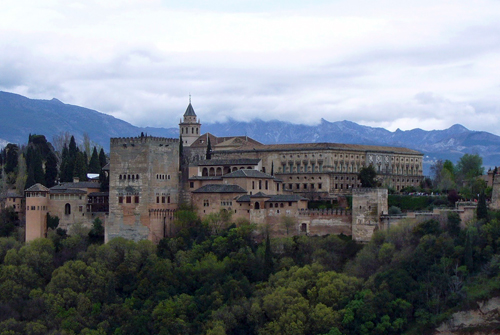
Photo by Camille Loiseau
Alhambra, Generalife and Albayzín in Granada
Rising above the modern lower town, the Alhambra and the Albaycín, situated on two adjacent hills, form the medieval part of Granada. To the east of the Alhambra fortress and residence are the magnificent gardens of the Generalife, the former rural residence of the emirs who ruled this part of Spain in the 13th and 14th centuries. The residential district of the Albaycín is a rich repository of Moorish vernacular architecture, into which the traditional Andalusian architecture blends harmoniously.
Antequera Dolmens Site
Located at the heart of Andalusia in southern Spain, the site comprises three megalithic monuments: the Menga and Viera dolmens and the Tholos of El Romeral, and two natural monuments: La Peña de los Enamorados and El Torcal mountainous formations, which are landmarks within the property. Built during the Neolithic and Bronze Age out of large stone blocks, these monuments form chambers with lintelled roofs or false cupolas. These three tombs, buried beneath their original earth tumuli, are one of the most remarkable architectural works of European prehistory and one of the most important examples of European Megalithism.
Aranjuez Cultural Landscape
The Aranjuez cultural landscape is an entity of complex relationships: between nature and human activity, between sinuous watercourses and geometric landscape design, between the rural and the urban, between forest landscape and the delicately modulated architecture of its palatial buildings. Three hundred years of royal attention to the development and care of this landscape have seen it express an evolution of concepts from humanism and political centralization, to characteristics such as those found in its 18th century French-style Baroque garden, to the urban lifestyle which developed alongside the sciences of plant acclimatization and stock-breeding during the Age of Enlightenment.
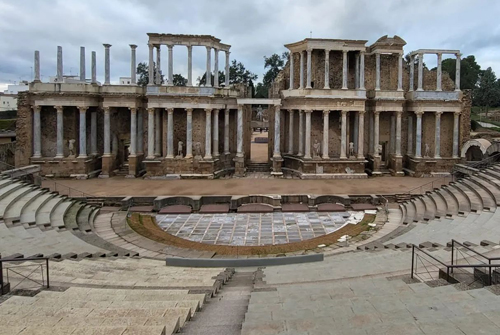
Archaeological Ensemble of Mérida
The colony of Augusta Emerita, which became present-day Mérida in Estremadura, was founded in 25 B.C. at the end of the Spanish Campaign and was the capital of Lusitania. The well-preserved remains of the old city include, in particular, a large bridge over the Guadiana, an amphitheatre, a theatre, a vast circus and an exceptional water-supply system. It is an excellent example of a provincial Roman capital during the empire and in the years afterwards.
Archaeological Ensemble of Tarraco
Tarraco (modern-day Tarragona) was a major administrative and mercantile city in Roman Spain and the centre of the Imperial cult for all the Iberian provinces. It was endowed with many fine buildings, and parts of these have been revealed in a series of exceptional excavations. Although most of the remains are fragmentary, many preserved beneath more recent buildings, they present a vivid picture of the grandeur of this Roman provincial capital.
Archaeological Site of Atapuerca
The caves of the Sierra de Atapuerca contain a rich fossil record of the earliest human beings in Europe, from nearly one million years ago and extending up to the Common Era. They represent an exceptional reserve of data, the scientific study of which provides priceless information about the appearance and the way of life of these remote human ancestors.
Burgos Cathedral
Our Lady of Burgos was begun in the 13th century at the same time as the great cathedrals of the Ile-de-France and was completed in the 15th and 16th centuries. The entire history of Gothic art is summed up in its superb architecture and its unique collection of works of art, including paintings, choir stalls, reredos, tombs and stained-glass windows.
Caliphate City of Medina Azahara
The Caliphate city of Medina Azahara is an archaeological site of a city built in the mid-10th century CE by the Umayyad dynasty as the seat of the Caliphate of Cordoba. After prospering for several years, it was laid to waste during the civil war that put an end to the Caliphate in 1009-1010. The remains of the city were forgotten for almost 1,000 years until their rediscovery in the early 20th century. This complete urban ensemble features infrastructure such as roads, bridges, water systems, buildings, decorative elements and everyday objects. It provides in-depth knowledge of the now vanished Western Islamic civilization of Al-Andalus, at the height of its splendour.
Catalan Romanesque Churches of the Vall de Boí
The narrow Vall de Boí is situated in the high Pyrénées, in the Alta Ribagorça region and is surrounded by steep mountains. Each village in the valley contains a Romanesque church, and is surrounded by a pattern of enclosed fields. There are extensive seasonally-used grazing lands on the higher slopes.

Photo by Camille Loiseau
Cathedral, Alcázar and Archivo de Indias in Seville
Together these three buildings form a remarkable monumental complex in the heart of Seville. The cathedral and the Alcázar – dating from the Reconquest of 1248 to the 16th century and imbued with Moorish influences – are an exceptional testimony to the civilization of the Almohads as well as that of Christian Andalusia. The Giralda minaret is the masterpiece of Almohad architecture. It stands next to the cathedral with its five naves; the largest Gothic building in Europe, it houses the tomb of Christopher Columbus. The ancient Lonja, which became the Archivo de Indias, contains valuable documents from the archives of the colonies in the Americas.
Cave of Altamira and Paleolithic Cave Art of Northern Spain
Seventeen decorated caves of the Paleolithic age were inscribed as an extension to the Altamira Cave, inscribed in 1985. The property will now appear on the List as Cave of Altamira and Paleolithic Cave Art of Northern Spain. The property represents the apogee of Paleolithic cave art that developed across Europe, from the Urals to the Iberian Peninusula, from 35,000 to 11,000 BC. Because of their deep galleries, isolated from external climatic influences, these caves are particularly well preserved. The caves are inscribed as masterpieces of creative genius and as the humanity’s earliest accomplished art. They are also inscribed as exceptional testimonies to a cultural tradition and as outstanding illustrations of a significant stage in human history.
Cultural Landscape of the Serra de Tramuntana
The Cultural Landscape of the Serra de Tramuntana located on a sheer-sided mountain range parallel to the north-western coast of the island of Mallorca. Millennia of agriculture in an environment with scarce resources has transformed the terrain and displays an articulated network of devices for the management of water revolving around farming units of feudal origins. The landscape is marked by agricultural terraces and inter-connected water works - including water mills - as well as dry stone constructions and farms.
Heritage of Mercury. Almadén and Idrija
The property includes the mining sites of Almadén (Spain), where mercury (quicksilver) has been extracted since antiquity, and Idrija (Slovenia), where mercury was first found in AD1490. The Spanish property includes buildings relating to its mining history, including Retamar Castle, religious buildings and traditional dwellings. The site in Idrija notably features mercury stores and infrastructure, as well as miners’ living quarters, and a miners’ theatre. The sites bear testimony to the intercontinental trade in mercury which generated important exchanges between Europe and America over the centuries. Together they represent the two largest mercury mines in the world, operational until recent times.

Historic Centre of Cordoba
Cordoba's period of greatest glory began in the 8th century after the Moorish conquest, when some 300 mosques and innumerable palaces and public buildings were built to rival the splendours of Constantinople, Damascus and Baghdad. In the 13th century, under Ferdinand III, the Saint, Cordoba's Great Mosque was turned into a cathedral and new defensive structures, particularly the Alcázar de los Reyes Cristianos and the Torre Fortaleza de la Calahorra, were erected.
Historic City of Toledo
Successively a Roman municipium, the capital of the Visigothic Kingdom, a fortress of the Emirate of Cordoba, an outpost of the Christian kingdoms fighting the Moors and, in the 16th century, the temporary seat of supreme power under Charles V, Toledo is the repository of more than 2,000 years of history. Its masterpieces are the product of heterogeneous civilizations in an environment where the existence of three major religions – Judaism, Christianity and Islam – was a major factor.
Historic Walled Town of Cuenca
Built by the Moors in a defensive position at the heart of the Caliphate of Cordoba, Cuenca is an unusually well-preserved medieval fortified city. Conquered by the Castilians in the 12th century, it became a royal town and bishopric endowed with important buildings, such as Spain's first Gothic cathedral, and the famous casas colgadas (hanging houses), suspended from sheer cliffs overlooking the Huécar river. Taking full advantage of its location, the city towers above the magnificent countryside.
La Lonja de la Seda de Valencia
Built between 1482 and 1533, this group of buildings was originally used for trading in silk (hence its name, the Silk Exchange) and it has always been a centre for commerce. It is a masterpiece of late Gothic architecture. The grandiose Sala de Contratación (Contract or Trading Hall), in particular, illustrates the power and wealth of a major Mediterranean mercantile city in the 15th and 16th centuries.
Las Médulas
In the 1st century A.D. the Roman Imperial authorities began to exploit the gold deposits of this region in north-west Spain, using a technique based on hydraulic power. After two centuries of working the deposits, the Romans withdrew, leaving a devastated landscape. Since there was no subsequent industrial activity, the dramatic traces of this remarkable ancient technology are visible everywhere as sheer faces in the mountainsides and the vast areas of tailings, now used for agriculture.
Monastery and Site of the Escurial in Madrid
Built at the end of the 16th century on a plan in the form of a grill, the instrument of the martyrdom of St Lawrence, the Escurial Monastery stands in an exceptionally beautiful site in Castile. Its austere architecture, a break with previous styles, had a considerable influence on Spanish architecture for more than half a century. It was the retreat of a mystic king and became, in the last years of Philip II's reign, the centre of the greatest political power of the time.
Monuments of Oviedo and the Kingdom of the Asturias
In the 9th century the flame of Christianity was kept alive in the Iberian peninsula in the tiny Kingdom of the Asturias. Here an innovative pre-Romanesque architectural style was created that was to play a significant role in the development of the religious architecture of the peninsula. Its highest achievements can be seen in the churches of Santa María del Naranco, San Miguel de Lillo, Santa Cristina de Lena, the Cámara Santa and San Julián de los Prados, in and around the ancient capital city of Oviedo. Associated with them is the remarkable contemporary hydraulic engineering structure known as La Foncalada.
Mudejar Architecture of Aragon
The development in the 12th century of Mudejar art in Aragon resulted from the particular political, social and cultural conditions that prevailed in Spain after the Reconquista. This art, influenced by Islamic tradition, also reflects various contemporary European styles, particularly the Gothic. Present until the early 17th century, it is characterized by an extremely refined and inventive use of brick and glazed tiles in architecture, especially in the belfries.
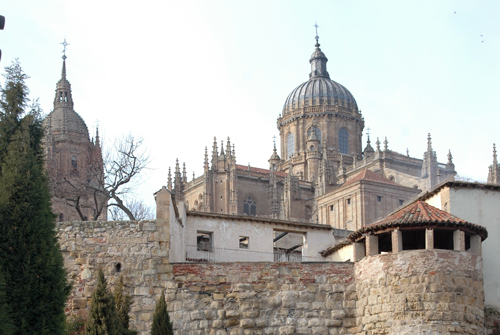
Old City of Salamanca
This ancient university town north-west of Madrid was first conquered by the Carthaginians in the 3rd century B.C. It then became a Roman settlement before being ruled by the Moors until the 11th century. The university, one of the oldest in Europe, reached its high point during Salamanca's golden age. The city's historic centre has important Romanesque, Gothic, Moorish, Renaissance and Baroque monuments. The Plaza Mayor, with its galleries and arcades, is particularly impressive.
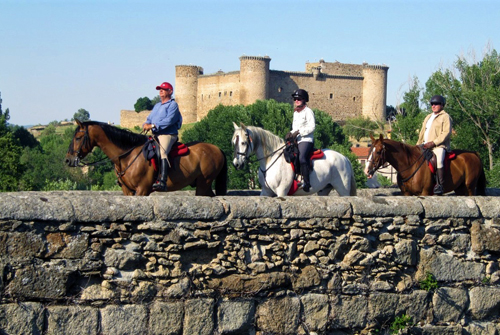
Old Town of Ávila with its Extra-Muros Churches
Founded in the 11th century to protect the Spanish territories from the Moors, this 'City of Saints and Stones', the birthplace of St Teresa and the burial place of the Grand Inquisitor Torquemada, has kept its medieval austerity. This purity of form can still be seen in the Gothic cathedral and the fortifications which, with their 82 semicircular towers and nine gates, are the most complete in Spain.
Old Town of Cáceres
The city's history of battles between Moors and Christians is reflected in its architecture, which is a blend of Roman, Islamic, Northern Gothic and Italian Renaissance styles. Of the 30 or so towers from the Muslim period, the Torre del Bujaco is the most famous.
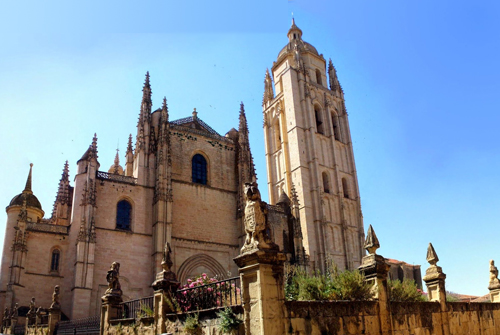
Photo by Camille Loiseau
Old Town of Segovia and its Aqueduct
The Roman aqueduct of Segovia, probably built c. A.D. 50, is remarkably well preserved. This impressive construction, with its two tiers of arches, forms part of the setting of the magnificent historic city of Segovia. Other important monuments include the Alcázar, begun around the 11th century, and the 16th-century Gothic cathedral.
Palau de la Música Catalana and Hospital de Sant Pau in Barcelona
These are two of the finest contributions to Barcelona's architecture by the Catalan art nouveau architect Lluís Domènech i Montaner. The Palau de la Música Catalana is an exuberant steel-framed structure full of light and space, and decorated by many of the leading designers of the day. The Hospital de Sant Pau is equally bold in its design and decoration, while at the same time perfectly adapted to the needs of the sick.
Palmeral of Elche
The Palmeral of Elche, a landscape of groves of date palms, was formally laid out, with elaborate irrigation systems, at the time the Muslim city of Elche was erected, towards the end of the tenth century A.C., when much of the Iberian peninsula was Arab. The Palmeral is an oasis, a system for agrarian production in arid areas. It is also a unique example of Arab agricultural practices on the European continent. Cultivation of date palms in Elche is known at least since the Iberian times, dating around the fifth century B.C.
Paseo del Prado and Buen Retiro, a landscape of Arts and Sciences
Located at the urban heart of Madrid, this cultural landscape evolved since the creation of the tree-lined Paseo del Prado avenue, a prototype of the Hispanic alameda, in the 16th century. The avenue features major fountains, notably the Fuente de Apolo and the Fuente de Neptuno, and the Fuente de Cibeles, an iconic symbol of the city, surrounded by prestigious buildings. The site embodies a new idea of urban space and development from the enlightened absolutist period of the 18th century. Buildings dedicated to the arts and sciences join others in the site that are devoted to industry, healthcare and research. Collectively, they illustrate the aspiration for a utopian society during the height of the Spanish Empire, linked to the enlightened idea of democratization of knowledge, and exercised major influence in Latin America. The 120-hectare Jardines del Buen Retiro (Garden of Pleasant Retreat), a remnant of the 17th-century Buen Retiro Palace, constitutes the largest part of the property. The site also houses the terraced Royal Botanical Garden and the largely residential neighbourhood of Barrio Jerónimos with its rich variety of 19th- and 20th-century buildings that include cultural and scientific venues.
Poblet Monastery
This Cistercian abbey in Catalonia is one of the largest in Spain. At its centre is a 12th-century church. The austere, majestic monastery, which has a fortified royal residence and contains the pantheon of the kings of Catalonia and Aragon, is an impressive sight.
Prehistoric Rock Art Sites in the Côa Valley and Siega Verde
The two Prehistoric Rock Art Sites in the Côa Valley (Portugal) and Siega Verde (Spain) are located on the banks of the rivers Agueda and Côa, tributaries of the river Douro, documenting continuous human occupation from the end of the Paleolithic Age. Hundreds of panels with thousands of animal figures (5,000 in Foz Côa and around 440 in Siega Verde) were carved over several millennia, representing the most remarkable open-air ensemble of Paleolithic art on the Iberian Peninsula.
Côa Valley and Siega Verde provide the best illustration of the iconographic themes and organization of Paleolithic rock art, using the same modes of expression in caves and in the open air, thus contributing to a greater understanding of this artistic phenomenon. Together they form a unique site of the prehistoric era, rich in material evidence of Upper Paleolithic occupation.
Renaissance Monumental Ensembles of Úbeda and Baeza
The urban morphology of the two small cities of Úbeda and Baeza in southern Spain dates back to the Moorish 9th century and to the Reconquista in the 13th century. An important development took place in the 16th century, when the cities were subject to renovation along the lines of the emerging Renaissance. This planning intervention was part of the introduction into Spain of new humanistic ideas from Italy, which went on to have a great influence on the architecture of Latin America.
Risco Caido and the Sacred Mountains of Gran Canaria Cultural Landscape
Located in a vast mountainous area in the centre of Gran Canaria, Risco Caído comprises cliffs, ravines and volcanic formations in a landscape of rich biodiversity. The landscape includes a large number of troglodyte settlements — habitats, granaries and cisterns — whose age is proof of the presence of a pre-Hispanic culture on the island, which has evolved in isolation, from the arrival of North African Berbers, around the beginning of our era, until the first Spanish settlers in the 15th century. The troglodyte complex also includes cult cavities and two sacred temples, or almogarenes — Risco Caído and Roque Bentayga — where seasonal ceremonies were held. These temples are thought to be linked to a possible cult of the stars and Mother Earth.
Rock Art of the Mediterranean Basin on the Iberian Peninsula
The late prehistoric rock-art sites of the Mediterranean seaboard of the Iberian peninsula form an exceptionally large group. Here the way of life during a critical phase of human development is vividly and graphically depicted in paintings whose style and subject matter are unique.
Roman Walls of Lugo
The walls of Lugo were built in the later part of the 3rd century to defend the Roman town of Lucus. The entire circuit survives intact and is the finest example of late Roman fortifications in western Europe.
Routes of Santiago de Compostela: Camino Francés and Routes of Northern Spain
A network of four Christian pilgrimage routes in northern Spain, the site is an extension of the Route of Santiago de Compostela, a serial site inscribed on the World Heritage List in 1993. The extension represents a network of almost 1,500 km: coastal, interior of the Basque Country–La Rioja, Liébana and primitive routes. It includes a built heritage of historical importance created to meet the needs of pilgrims, including cathedrals, churches, hospitals, hostels and even bridges. The extension encompasses some of the earliest pilgrimage routes to Santiago de Compostela, following the discovery in the 9thcentury of a tomb believed to be that of St. James the Greater.
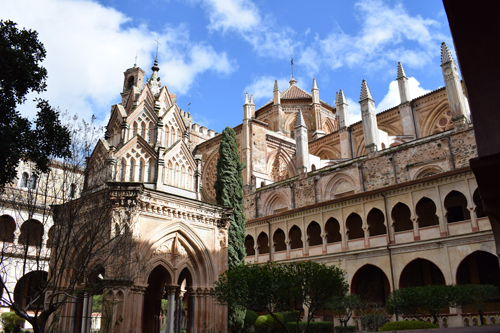
Royal Monastery of Santa María de Guadalupe
The monastery is an outstanding repository of four centuries of Spanish religious architecture. It symbolizes two significant events in world history that occurred in 1492: the Reconquest of the Iberian peninsula by the Catholic Kings and Christopher Columbus' arrival in the Americas. Its famous statue of the Virgin became a powerful symbol of the Christianization of much of the New World.
San Cristóbal de La Laguna
San Cristóbal de La Laguna, in the Canary Islands, has two nuclei: the original, unplanned Upper Town; and the Lower Town, the first ideal 'city-territory' laid out according to philosophical principles. Its wide streets and open spaces have a number of fine churches and public and private buildings dating from the 16th to the 18th century.
San Millán Yuso and Suso Monasteries
The monastic community founded by St Millán in the mid-6th century became a place of pilgrimage. A fine Romanesque church built in honour of the holy man still stands at the site of Suso. It was here that the first literature was produced in Castilian, from which one of the most widely spoken languages in the world today is derived. In the early 16th century the community was housed in the fine new monastery of Yuso, below the older complex; it is still a thriving community today.
Santiago de Compostela (Old Town)
This famous pilgrimage site in north-west Spain became a symbol in the Spanish Christians' struggle against Islam. Destroyed by the Muslims at the end of the 10th century, it was completely rebuilt in the following century. With its Romanesque, Gothic and Baroque buildings, the Old Town of Santiago is one of the world's most beautiful urban areas. The oldest monuments are grouped around the tomb of St James and the cathedral, which contains the remarkable Pórtico de la Gloria.
Tower of Hercules
The Tower of Hercules has served as a lighthouse and landmark at the entrance of La Coruña harbour in north-western Spain since the late 1st century A.D. when the Romans built the Farum Brigantium. The Tower, built on a 57 metre high rock, rises a further 55 metres, of which 34 metres correspond to the Roman masonry and 21 meters to the restoration directed by architect Eustaquio Giannini in the 18th century, who augmented the Roman core with two octagonal forms. Immediately adjacent to the base of the Tower, is a small rectangular Roman building. The site also features a sculpture park, the Monte dos Bicos rock carvings from the Iron Age and a Muslim cemetery. The Roman foundations of the building were revealed in excavations conducted in the 1990s. Many legends from the Middle Ages to the 19th century surround the Tower of Hercules, which is unique as it is the only lighthouse of Greco-Roman antiquity to have retained a measure of structural integrity and functional continuity.
University and Historic Precinct of Alcalá de Henares
Founded by Cardinal Jiménez de Cisneros in the early 16th century, Alcalá de Henares was the world's first planned university city. It was the original model for the Civitas Dei (City of God), the ideal urban community which Spanish missionaries brought to the Americas. It also served as a model for universities in Europe and elsewhere.
Vizcaya Bridge
Vizcaya Bridge straddles the mouth of the Ibaizabal estuary, west of Bilbao. It was designed by the Basque architect Alberto de Palacio and completed in 1893. The 45-m-high bridge with its span of 160 m, merges 19th-century ironworking traditions with the then new lightweight technology of twisted steel ropes. It was the first bridge in the world to carry people and traffic on a high suspended gondola and was used as a model for many similar bridges in Europe, Africa and the America only a few of which survive. With its innovative use of lightweight twisted steel cables, it is regarded as one of the outstanding architectural iron constructions of the Industrial Revolution.
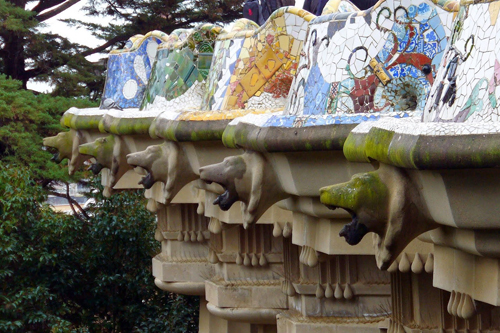
Photo by Camille Loiseau
Works of Antoni Gaudí
Seven properties built by the architect Antoni Gaudí (1852–1926) in or near Barcelona testify to Gaudí’s exceptional creative contribution to the development of architecture and building technology in the late 19th and early 20th centuries. These monuments represent an eclectic, as well as a very personal, style which was given free reign in the design of gardens, sculpture and all decorative arts, as well as architecture. The seven buildings are: Parque Güell; Palacio Güell; Casa Mila; Casa Vicens; Gaudí’s work on the Nativity façade and Crypt of La Sagrada Familia; Casa Batlló; Crypt in Colonia Güell.
Ancient and Primeval Beech Forests of the Carpathians and Other Regions of Europe
This transnational property includes 94 component parts in 18 countries. Since the end of the last Ice Age, European Beech spread from a few isolated refuge areas in the Alps, Carpathians, Dinarides, Mediterranean and Pyrenees over a short period of a few thousand years in a process that is still ongoing. The successful expansion across a whole continent is related to the tree’s adaptability and tolerance of different climatic, geographical and physical conditions.
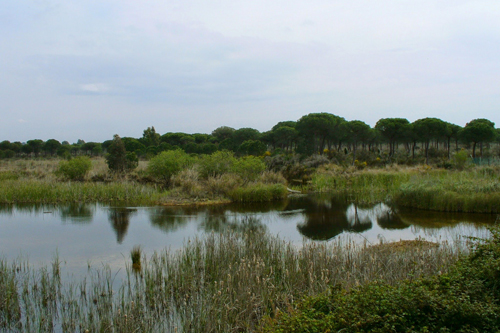
Photo by Camille Loiseau
Doñana National Park
Doñana National Park in Andalusia occupies the right bank of the Guadalquivir river at its estuary on the Atlantic Ocean. It is notable for the great diversity of its biotopes, especially lagoons, marshlands, fixed and mobile dunes, scrub woodland and maquis. It is home to five threatened bird species. It is one of the largest heronries in the Mediterranean region and is the wintering site for more than 500,000 water fowl each year.
Garajonay National Park
Laurel forest covers some 70% of this park, situated in the middle of the island of La Gomera in the Canary Islands archipelago. The presence of springs and numerous streams assures a lush vegetation resembling that of the Tertiary, which, due to climatic changes, has largely disappeared from southern Europe.
Teide National Park
Situated on the island of Tenerife, Teide National Park features the Teide-Pico Viejo stratovolcano that, at 3,718 m, is the highest peak on Spanish soil. Rising 7,500 m above the ocean floor, it is regarded as the world’s third-tallest volcanic structure and stands in a spectacular environment. The visual impact of the site is all the greater due to atmospheric conditions that create constantly changing textures and tones in the landscape and a ‘sea of clouds’ that forms a visually impressive backdrop to the mountain. Teide is of global importance in providing evidence of the geological processes that underpin the evolution of oceanic islands.
Ibiza, Biodiversity and Culture
Ibiza provides an excellent example of the interaction between the marine and coastal ecosystems. The dense prairies of oceanic Posidonia (seagrass), an important endemic species found only in the Mediterranean basin, contain and support a diversity of marine life. Ibiza preserves considerable evidence of its long history. The archaeological sites at Sa Caleta (settlement) and Puig des Molins (necropolis) testify to the important role played by the island in the Mediterranean economy in protohistory, particularly during the Phoenician-Carthaginian period. The fortified Upper Town (Alta Vila) is an outstanding example of Renaissance military architecture; it had a profound influence on the development of fortifications in the Spanish settlements of the New World.
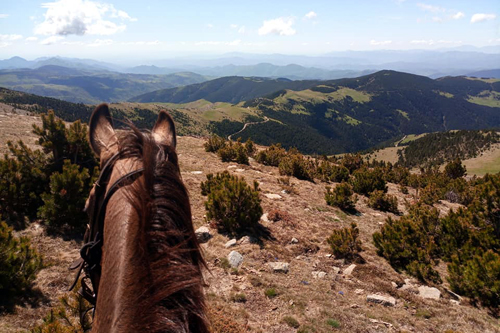
Pyrénées - Mont Perdu
This outstanding mountain landscape, which spans the contemporary national borders of France and Spain, is centred around the peak of Mount Perdu, a calcareous massif that rises to 3,352 m. The site, with a total area of 30,639 ha, includes two of Europe's largest and deepest canyons on the Spanish side and three major cirque walls on the more abrupt northern slopes with France, classic presentations of these geological landforms. The site is also a pastoral landscape reflecting an agricultural way of life that was once widespread in the upland regions of Europe but now survives only in this part of the Pyrénées. Thus it provides exceptional insights into past European society through its landscape of villages, farms, fields, upland pastures and mountain roads.
Source: https://whc.unesco.org/en/statesparties/es
|
|

|
|
|
|